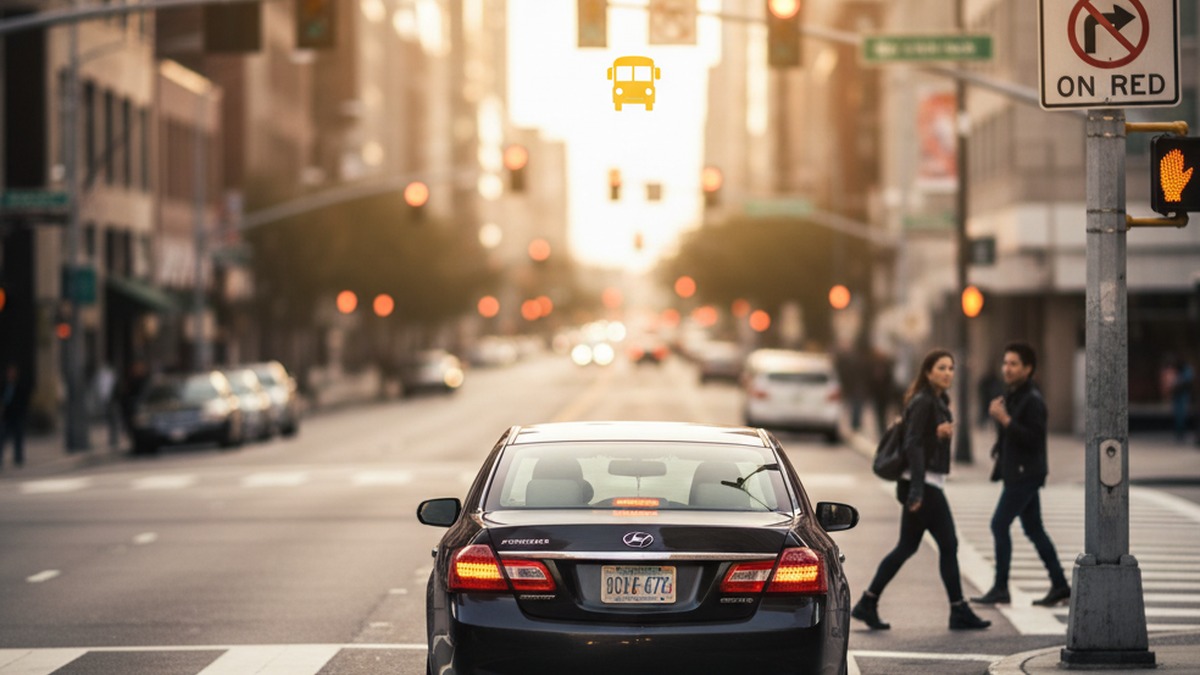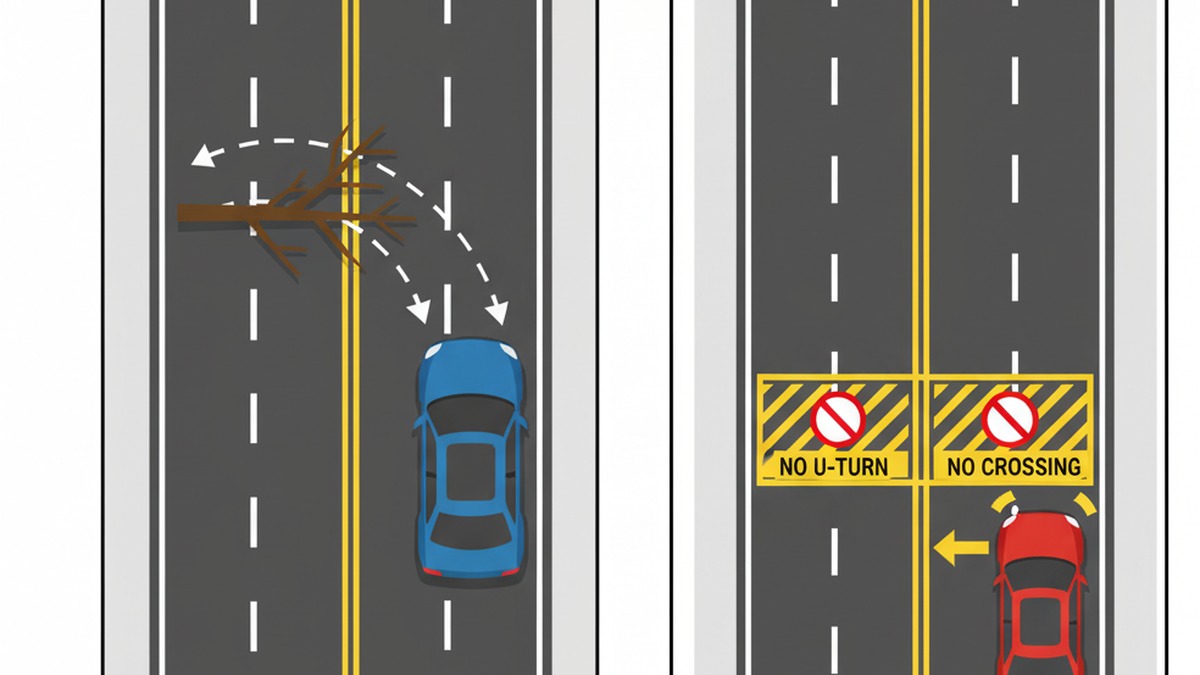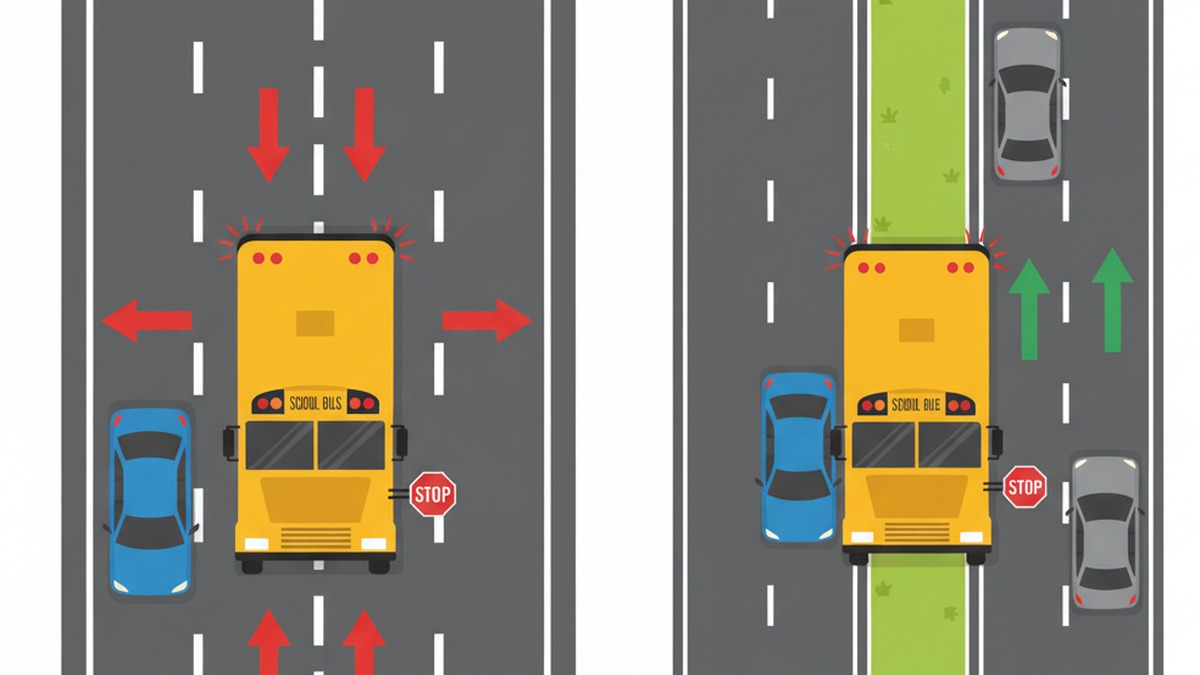
This guide distills the rules of the road drivers search for most in the United States—right turns on red, double-yellow no-passing centerlines, school-bus stop laws, and pedestrian/cyclist priority. While each state publishes its own statute or driver handbook, the patterns below are remarkably consistent. Use this page as a quick reference and follow the in-text links to deeper state-specific explainers and diagrams.
You must make a complete stop before turning right on red
In states that allow right turn on red, the baseline rule is a complete stop at the limit line or before the crosswalk. After stopping, yield to pedestrians and any vehicles with the right-of-way. A NO TURN ON RED sign overrides the general allowance—sometimes permanently, sometimes only during posted hours (e.g., 7–9 AM, 4–6 PM). Arrows also matter: a red right arrow behaves like a solid red for the movement the arrow controls.
Reading "NO TURN ON RED" and time-based sign restrictions
Municipal corridors with heavy foot traffic or limited sight distance often post restrictions. If the plaque lists hours, the ban applies only within that window. In school zones, a flashing beacon or time plate may synchronize with arrival/dismissal periods. When in doubt, assume the restriction applies and proceed on green.
School hours, arrows, and flashing signals explained
A flashing yellow arrow permits a cautious turn after yielding; a flashing red requires a full stop before proceeding. Near schools, you may also see "NO TURN ON RED when children are present"—courts typically interpret that phrase to mean children are within the crosswalk or at the curb waiting to cross.
Pedestrian and cyclist right-of-way priorities
People in a marked or unmarked crosswalk have priority. Cyclists riding in a bike lane straight through the intersection likewise have the right-of-way. Move only when the crosswalk is clear and you can complete your turn without forcing a person on foot—or on a bike—to slow, stop, or swerve.
Red-light camera enforcement pitfalls
Most automated systems look for a rolling right turn that never fully stops. Keep your front wheels behind the limit line, pause, check both ways, then turn if permitted. Our deeper guide covers signage examples and state variations: see Right Turn on Red: Rules, Signs, Exceptions.
Double-yellow centerline rules: no-passing zones and narrow exceptions
A double-yellow line marks a no-passing zone for traffic in both directions. Crossing the line to overtake is illegal and dangerous because sight distance is limited by curves, hills, or urban friction. However, most states carve out two narrow use cases: (1) left turns into a driveway, alley, or side street; and (2) temporary obstruction avoidance when there is no other safe option and sight distance is clear.
Avoiding an obstruction across double yellow (the "only as far as necessary" rule)
Imagine a fallen branch, stalled car, or delivery vehicle blocking your lane. If crossing the centerline a small distance is truly the safest course, states that allow it also require a "quick return" once past the obstacle and prohibit using the exception to pass another moving vehicle.

"Double-double" painted median barriers and legal openings
Some corridors—especially in California—paint two sets of double yellow lines with a hashed buffer between them. Treat this as a median barrier. Do not make a U-turn or left turn across it unless you are at a signed opening. We catalog practical examples in Two Sets of Double Yellow Lines: Barrier Rules.
Left turn across double yellow into a driveway
A standard double-yellow (not a painted median) may be crossed to turn left into a driveway or side street if the maneuver is legal, safe, and not signed otherwise. Yield to oncoming traffic and be mindful of bike lanes adjacent to the centerline. Our dedicated explainer adds diagrams and ticket hot spots: Left Turn Across Double Yellow.
Common tickets tied to centerlines
Typical citations include improper passing, unsafe U-turn across a barrier, and failure to obey a traffic control device (e.g., "NO U-TURN"). When a crash or near-miss occurs, officers often cite "basic speed" or "due care" statutes in addition to the centerline violation.
School bus stop laws: when both directions must stop
On an undivided roadway, traffic in both directions must stop when a school bus displays flashing red lights and a stop arm. On a divided highway with a physical median (raised curb, grass, or concrete), the opposite direction usually does not stop—though reduced speed and extra caution are still expected. Always follow instructions from school crossing guards.

Flashing lights, stop arm, and school safety corridors
Yellow flashing lights warn that a stop is imminent. Red flashing lights and the deployed stop arm require a stop—no creeping past. Many jurisdictions designate school safety corridors with speed cameras or bus stop-arm cameras. Expect fines, points, and possible license restrictions for violations.
Penalty ranges and insurance considerations
Penalties vary widely by state but frequently include several hundred dollars in fines, multiple points, and insurance surcharges. Repeat offenses and incidents with children in the roadway elevate consequences substantially. Review our focused guide: School Bus Stop Laws: Must You Stop Both Ways?.
Work zones and temporary traffic control
Flaggers, portable signals, and lane shifts can temporarily override the usual pattern of signs and markings. Flagger directions overrule markings. If a double yellow is taped over or cones redirect you across it, the detour is legal as long as you follow the instructions given.
Verify with official sources
Because statutes update, always cross-check with your state's driver handbook or vehicle code. We maintain state pages that point you to the primary sources for quick verification.
Right-of-way & lane-use: crosswalks, roundabouts, and merges
Most conflicts are solved by three principles: (1) yield to pedestrians lawfully in a crosswalk; (2) yield to traffic already in the roundabout; and (3) when lanes merge, continue at a steady speed and take turns (zipper merge) when space is limited. Signal early. Make smooth, predictable movements.
Pedestrian right-of-way at marked and unmarked crosswalks
Every intersection has crosswalks—some are simply unmarked. If a person steps into your lane or is within one lane of your side of the road, you must yield. At multi-lane streets, stop before the crosswalk so you don't screen pedestrians from approaching traffic.
Roundabout priorities and lane selection
Slow to the advisory speed, yield to traffic already circulating, and choose a lane before entry that matches your exit. Do not stop within the circulating lane unless necessary. For turning rules at signals after the roundabout, review Roundabout Right-of-Way.
Merges, bike lanes, and bus priority
Merge at the lane-end using a zipper pattern; do not block the ending lane far in advance. Before turning right, merge across the bike lane when broken lines begin, then turn from the curbside position. In transit priority corridors, yield to buses pulling out from a stop where required.
Common mistakes that trigger tickets
- Rolling right turn on red without a full stop.
- Crossing a painted median ("double-double") to make a U-turn.
- Passing a stopped school bus with red lights and stop arm out.
- Blocking a crosswalk or bike lane while waiting to turn.
Quick links to deeper explainers & state pages
Interested in the edge cases, diagrams, and citations? Start here:
- Right Turn on Red: Rules, Signs, Exceptions
- You May Cross a Double Solid Yellow Line?
- Two Sets of Double Yellow Lines (Painted Median)
- School Bus Stop Laws: Stop Both Ways vs. Divided
- California Double-Yellow Rules
Related Reading
This article summarizes common rules. Always consult your state statute and posted signs for the most current regulations.